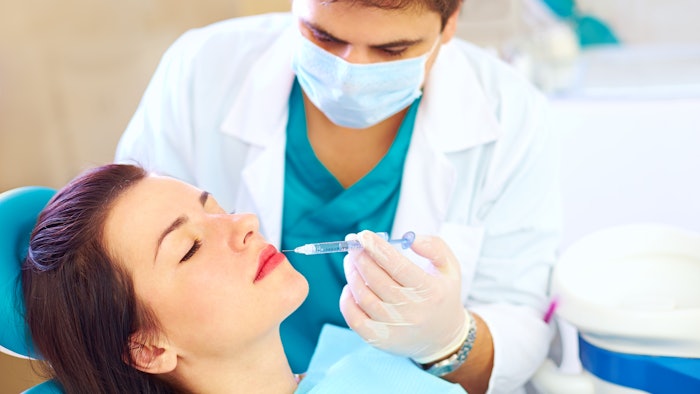
A study in the January 2023 issue of the Plastic and Reconstructive Surgery journal analyzed different injection techniques to determine the safest way to deliver soft tissue filler injections. It found that for a sharp needle, static injection in the periosteum layer after effective withdrawal is recommended for maximum safety. For a cannula, retrograde injection after gentle insertion into loose tissues is recommended.
Related: Guidelines for Botulinum Neurotoxin Facial Contouring Injections
The study, conducted by Zhang, Lei MD; Feng, Xiao M.D., et. al, used 31 fresh frozen cadavers of Han Chinese ethnicity for the mimetic injections and anatomic analysis. The specimens were perfused with red latex within arteries and blue latex within veins. Cadaver mimetic filler injections with colored hyaluronic acid (HA) were performed with a sharp needle and cannula.
Injection Techniques
The sharp needle was set perpendicular to the skin surface and penetrated deeply until touching the bone, at which time injection was performed. The cannula was inserted from a prepared hole, located 15 to 20 degrees to the skin surface, and moved forward and backward gently until passing through the tissues, followed by retrograde injection.
The HA injected with the sharp needle was located mainly within or under the periosteum and part of the HA would flow reversely into the periosteum or the deep fat compartments For the cannula injection, in the forehead, temple, periorbital, nose and nasal labial fold regions, the injected HA was located under the superficial muscular aponeurotic system, some of which was in the deep fat compartments, whereas in cheek, lips, mandibular and nasal labial fold, the injected HA was mainly located in the subcutaneous fat layer, per the study.
Distribution of Injected HA
Along with safe injection techniques, the study also found that the distribution of injected HA by cannula cannot be controlled as expected by the operator, because the cannula cannot be inserted into tissues as freely as the sharp needle. It cannot pass through dense tissues with a gentle push; it can only pass through loose tissues, usually located beneath the superficial muscular aponeurotic system. In the nasal labial fold, mandible and cheek areas, the injected HA sometimes was also found in the superficial fat layer.
Hyaluronic acid was mainly found in the deep medial cheek fat and deep surface of the levator labii superiors (LLS) and levator labii superioris alaeque nasi (LLSAN). The injected HA was also occasionally located in subcutaneous fat on the superficial lay of LLS and LLSAN











